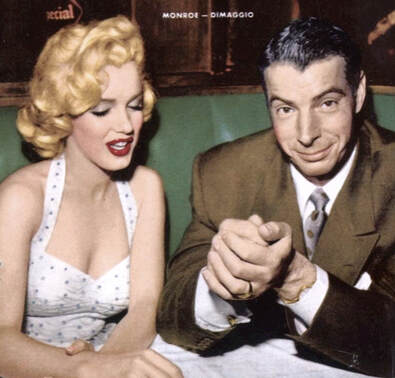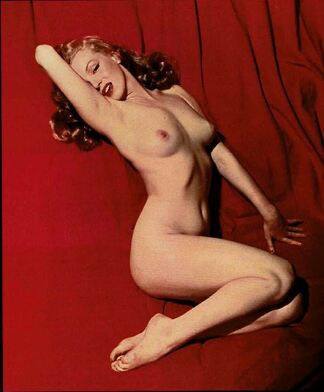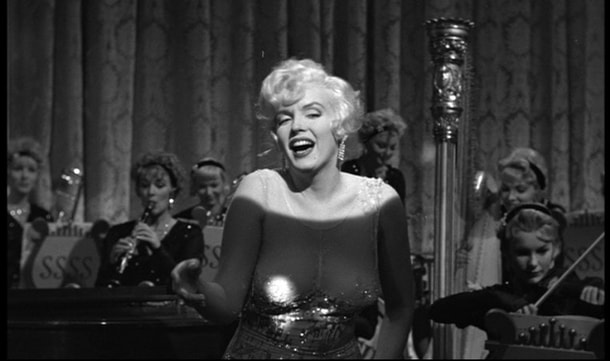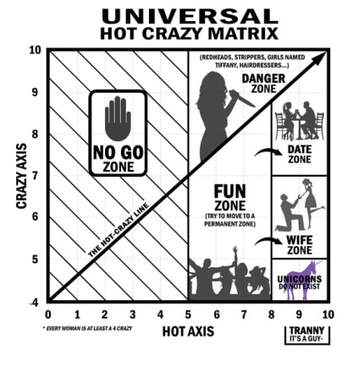 Marilyn Monroe (MM) is maybe the most celebrated and well known of all actresses. A true legend of the screen, I counted a dozen books about her on Amazon. Imdb.com credits her with an astonishing 75 print biographies and 864 magazine cover photos, proving once again that everyone loves a real life Cinderella story. She was born Norma Jeane Mortenson on June 1, 1926, in the charity ward of the Los Angeles General Hospital. She had a hard knock life. Prior to her birth, Norma Jeane’s father abandoned his pregnant girlfriend. Norma Jeane was raised in a low-income, single parent family. Her mother, Gladys Baker, suffered from mental illness and was in and out of mental institutions; consequently, Norma Jeane spent her younger years in foster homes and orphanages. In 1942 she dropped out of high school and became a teenage bride (age 16). She modeled and her husband went into the army. Marriage #1 lasted about four years. Norma Jeane bloomed into a full-figured beauty, and began modeling swimsuits. She dreamed of an acting career and her agent shopped her modeling photos around Hollywood. Soon she was offered her first, rather modest, contract with 20th Century-Fox, and adopted the stage name, Marilyn Monroe. And so she began her start in the movie business, playing a few bit parts and modeling to make a living. Constantly short of cash, Noma Jeane posed nude for a calendar shot in 1949, she explained years later, “I needed the money to get my car out of hock.” More about the calendar shot later. Miss Monroe’s big break came in 1950 when she played minor roles in four movies, including two films directed by Hollywood legends; John Huston’s film noir classic, The Asphalt Jungle, and Joseph Mankiewicz’s Oscar champ, All About Eve (14 Oscar nominations and 6 wins, including Best Picture for 1950.) With that kind of attention and box office success, movie fans noticed Miss Monroe for her brief yet very sexy screen presence. Movie critics gave her positive reviews. By 1952 she was playing in starring roles and became a genuine box-office draw. Also in 1952 she began dating retired Yankee baseball legend, Joe DiMaggio. After a fairy tale romance, she married Joe in 1954. Her movie career was in full swing, but unfortunately her fame brought out an ugly, jealous side of DiMaggio. Joe insisted she quit the movie business; she refused and filed for a divorce on Joe in 1955. An amicable divorce resulted, and Joe was very generous with the divorce settlement. Marilyn never spoke a bad word about him. In 1953 an ambitious magazine publisher named Hugh Hefner paid $500 for the rights to Marilyn’s nude calendar shot. In December Hefner’s magazine, named Playboy, hit the newsstands with a glamour shot of Marilyn on the cover and her nude photo inside as the first “Sweetheart of the Month”. Playboy became an immediate success and Hefner was soon a multi-millionaire. Marilyn never saw a dime from Hefner. The 1959 screwball comedy, Some Like It Hot, is perhaps her most famous and popular movie. The film is rated an 8.2 on Imdb. Roger Ebert gave the movie 4 stars, his highest rating. She co-stars with Tony Curtis and Jack Lemmon and plays Sugar Cane Kowalczyk, a singer in an all-girl band (see photo below). Monroe’s last movie, co-starring with Clark Gable was The Misfits in 1961. By then her emotional problems and drug dependency were getting out of hand. Her director, John Huston, enrolled her into a detox clinic in order to help her regain some balance. She was able to finish the film. Marilyn died in 1962. She was only 36 years old. LA coroner ruled the cause of death as drug overdose. I watched the six movies reviewed below in June 2021 on a classic movie channel that showcased Marilyn Monroe movies in June. She cemented her reputation as a successful light comedy actress, but I also included her dramatic roles as a lead actress that go against type. She was an underrated versatile and talented actress. We begin with her small role in the film that put our blonde knockout on the star map, All About Eve, and end with her last film, The Misfits. My favorite MM films are the other four. All About Eve 1950 drama The director openly admitted that he chose the lead actresses for this film because they displayed "bitch charisma and virtuosity". How interesting and honest is that? The ladies portrayed in the film are strong-willed and know how to wield power. The male contingent is mostly relegated to the rear of the bus while the dueling divas of the Broadway stage are in complete control. One is hard pressed to find a modern movie quite as liberated, or feminist-driven as this film. The plot is simple and effective. Aspiring actress Eve Harrington (Anne Baxter) cleverly maneuvers her way into the inner circle of theater friends of Broadway star, Margo Channing (Betty Davis), and the battle royal begins with selfish ambition, manipulation and betrayal all around. Top notch ensemble cast without a single weak link. After all the years, this motion picture still holds the record for the greatest number of female acting Oscar nominations. One of my favorite scenes has several people sitting on a stairway at Margo’s party (see photo above). There is tension in the air as Margo and Eve maneuver toward a hostile showdown. A curvaceous Miss Casswell, Marilyn Monroe looking young and fresh, adds some much needed comedy relief. She desires another drink, and yells out, "Oh waiter!" Her date, Addison schools her: "That isn't a waiter, my dear; that's a butler." To which she fires back: "Well I can't yell 'Oh butler', can I? Maybe somebody's name is Butler". Addison then concedes: "You have a point, an idiotic one, but a point." Nice! Don’t Bother to Knock 1952 drama, psyche-thriller If you think, like I did, that Marilyn Monroe (MM) was only cast as a dizzy blonde in light comedy, then you should watch Don’t Bother to Knock. This movie features one of MM’s rare (first?) starring roles, and has her very best acting performance of the batch of movies that I recently watched. Marilyn gets high marks for portraying a very disturbed woman, Nell Forbes, without over acting the part - only a gesture or the look in her eyes sends the message. She seemed so authentically confused and lost and vulnerable. This is the only film that really taps into the 'damaged Persona' or neurotic quality of the real MM, and uses it as an indispensable element to drive the movie. Nell, one-by-one, ticks every box indicating manic depressive with a touch of schizophrenia. Richard Widmark is also very good in this picture. He usually played villains, but in this film he was cast as a nice person and the love interest. His girlfriend is Anne Bancroft, an intelligent and sweet, nightclub singer in the hotel lounge. They chat in between her numbers, but when he makes it clear he’s not the marrying kind, she breaks off the romance. He leaves the lounge dejected and upset but perks up when he meets Nell Forbes. At first, Widmark is infatuated with Nell’s beauty, and it is fun to watch Widmark slowly size up Nell on the Universal Hot Crazy Matrix (see chart below). Enough plot – no spoilers. This film is far better than I expected and I was hooked on MM movies. Monkey Business 1952 screwball-comedy Despite our today’s advanced technology, science still has not discovered “Love Potion #9” or a magical tonic for the “Fountain of Youth”. But wait a minute. Did an unknown chemist discover a magical, anti-aging tonic in Hollywood back in 1952? Yes, of course. Cary Grant plays a bumbling, “genius” chemist, Mr. Barnaby, to perfection. If he wasn't the finest light comedian that film has ever produced, he was extremely close. I always thought he was miscast in any serious dramatic role. Some people rave about him in Charade, and North by Northwest but he always seemed to be “acting” a role. He was not natural or convincing; I could not buy into his too-fake characters in dramatic films. The opposite is true in Monkey Business. No matter how goofy or slapsticky the scene, he made it work and made it funny. Ginger Rogers, playing Barnaby’s understanding wife, also was a gifted comedian, and in one of the best scenes she also shows off her excellent dancing skills. She danced as light on her feet in 1952 as she did in the 1930’s with Fred Astaire. It must have been the magic tonic that she drank by mistake. Marilyn Monroe was the best in the business at playing the sexy, dizzy blonde and thus is perfectly cast. She makes the best of her minor role as the office secretary and steals every scene she played. A young Morgan Freeman makes a special appearance as lab assistant, Jasper, and stumbles onto the magic formula which, for some reason, he deposits into the office water cooler with hilarious results. Niagara 1953 drama crime This movie was on my film noir watch list, so when it showed up on the classic movie channel I popped up some corn and put my feet up. One good reason to watch this movie is to see Marilyn Monroe star as a dangerous femme fatale, a very new and unique role for her. MM, as Rose Loomis, is the opposite of her light comedy roles and she nails it. Marilyn Monroe was surely at the peak of her beauty and sensuality in 1953. The film itself is a lovely snapshot of the 1950s and the Niagara Falls area is captured in glorious Technicolor. The support casting is solid – especially Jean Peters as new bride, Polly Cutler. Polly’s wholesome prettiness and modesty is in sharp contrast to Monroe wearing a magenta va-va-voom dress. The plot is fairly simple, or so it seems, when an innocent honeymoon couple, the Cutlers, befriend another couple, Rose and George, staying at the same resort hotel. It does not take long before Polly’s fine-tuned female intuition is flashing warning signs about their new friends at the resort. George, played by Joseph Cotton, broods and displays a nasty temper. Rose is detached with not much affection towards George. Polly figures out that Rose has a lover boy on the side, making for dangerous love triangle that is about to go off the rails, all according to Rose’s clever secret plan. When George fails to show up at the hotel, Rose innocently turns to the Cutler’s for help finding George. The acting by all the main characters is terrific, particularly in any scene when the dark side of Rose emerges. The pace of the film quickens in the last half of and there is a surprising twist or two and a good deal of action. Polly proved herself to be very strong and quick-witted lady. I definitely recommend this film, not just for film noir fans and Monroe fans, but for any movie fan. This one is a classic time capsule of the early 1950’s that has aged like a fine wine with a timeless theme. The Seven Year Itch 1955 comedy There is a heat wave in NYC. MM as “the Girl in the upstairs apartment” wearing white summer dresses performs her hottest role to date and kicked up her star power. This is the movie with the scene where she stands on the sidewalk grating with the exhaust air blowing her skirt up. Somehow those high heels did not get planted in the grating. For a movie about a married man, Sherman, who gets frisky after his wife and son leave town for vacation, the film is shockingly wholesome. MM, “the Girl”, has little interest in Sherman except for the fact that his apt has A/C and hers does not. Funniest scene – at the piano bench, Sherman is smitten and hugs and kisses MM, and they fall backward off the bench. He apologizes profusely, “this has never happen to me before.” Marilyn calmly adjusts her skirt and hair and deadpans a reply, “It happens to me all the time.” LOL! In fact most of the physical comedy in the film is executed by Monroe herself. The veteran Broadway actor in the film, Tom Ewell, pales by comparison, and seems to have lost most of his marbles. The movie drags a bit with MM off screen. Marilyn’s innocence and feminine charm, mixed with the light comedy screenplay, proved to be very popular with movie fans. Monroe and writer-director Billy Wilder would team up again with the same formula four years later in “Some Like It Hot”. The Misfits 1961 drama western This was the last film for two Hollywood legends, Clark Gable and Marilyn Monroe. Gable died two weeks after completing the film. Marilyn died the following year. The movie set was plagued with problems from the very beginning. Marilyn’s marriage to Arthur Miller was on the rocks, and she was having emotional problems. The alcoholic Montgomery “Monty” Clift was drinking like a fish, causing Marilyn to remark about Monty, “I’ve never met someone in worse shape than me.” The director, John Huston, was on the losing end of a gambling binge and often arrived to work tardy and tired. To make matters worse, the production did not kick off until the height of a 100*F summer in the Arizona desert. They all somehow managed to stumble over the finish line. It is no wonder this film is a bit of a mess. I wanted to like this final film by two famous stars, but I must not have been in the mood for so much despair of disappointed hopes and dreams. Some good performances if you don’t mind a very downbeat movie. THE END |
AuthorWritten by Ben Clark. Copyright 2016-2023. All rights reserved. Check out my new book, available on Amazon Kindle!Archives
February 2022
|













